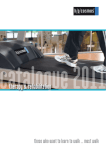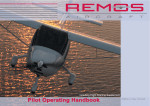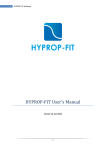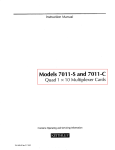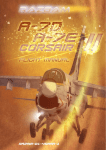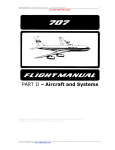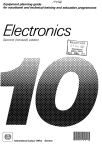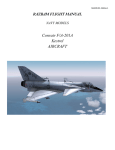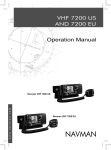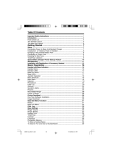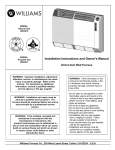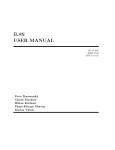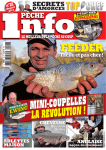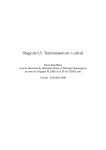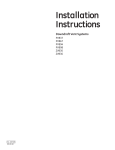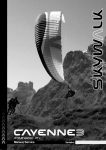Download T-2 Buckeye User`s Manual
Transcript
RAZBAM FLIGHT MANUAL NAVY MODELS T-2A, T-2B, T-2C, T-2D & T-2E BUCKEYE AIRCRAFT RAZAIR 01 60GAB 1 RAZBAM Flight Manual - NAVY Models • T-2A, T-2B, T-2C, T-2D & T-2E BUCKEYE RAZAIR 01 60GAB 1 3 CONTROL CONFIGURATION Since the T-2 Buckeye is a military airplane capable of dropping ordnance the following controls must be mapped. Weapons Release (Trigger) The airplane armament release function is dependent on the setting of certain switches. Unfortunately FSX does not provide support for that feature. In order to be able to drop ordnance in both free flight and missions the following key map must be used: Joystick Button 01: Cabin alert – Seatbelts (on/off). Thank you for your purchase of RAZBAM’s North American/Republic T-2 Buckeye aircraft model. We at RAZBAM have worked to deliver to you the most accurate model of this fascinating aircraft and we promise you that you will enjoy flying it. The T-2 Buckeye is a two place subsonic trainer, powered by two axial flow turbojets (In the case of the T-2J 1 S also designated as the T-2A the aircraft is powered by a single turbojet. The Buckeye was well designed for field maintenance conditions, with serviceable components installed at waist level or lower. Thus, the need for stands and ladders for most routine maintenance, including fueling, was eliminated. While training more than 11,000 student pilots to fly 18 different models of Navy jet aircraft, the Buckeye established an outstanding record of safety and reliability for many years, but as the machine has aged it has developed some problems, being grounded for safety reasons three times in 1997 alone. After 41 years of service, the North American T2 "Buckeye" jet trainer was phased out, in favor of the Boeing/BAE T 45A "Goshawk." The package that you have purchased contains the following models: T-2A (T-2J 1 S), T-2B. T-2C used by the U.S. Navy and U.S.M.C., the T-2E used by the Venezuelan Air Force (Fuerza Aérea Venezolana) and the T-2E used by the Hellenic Air Force (Πολεμική Αεροπορία). All models can load weapons. The T-2D and T-2E have been modeled with the Armament Kit that added another two hard points in the wings. (See figure below) If you do not have a joystick, set any keyboard combination to this event. Note: The default keyboard combination for dropping objects still works in missions, but it won’t trigger the weapons animation. Copyright © 2011-2012 by RAZBAM. This package contains files and work by RAZBAM under permission. INTRODUCTION RAZBAM Flight Manual - NAVY Models • T-2A, T-2B, T-2C, T-2D & T-2E BUCKEYE RAZAIR 01 60GAB 1 4 Switch SWITCHES NAVIGATION AIRCRAFT TheT-2’s cockpit instruments have several types of switches, pushbuttons, knobs and levers. Usually you only have to click with your left mouse button on the switch to have it change its position, but there are several that have multiple positions that move back and forth. For these multiple position switches and knobs you have to left click to go forward and right click to go backwards. The following is a chart of the different switches and knobs found on the cockpit and how to navigate them. Switch Type Navigation The T-2 Buckeye is a two place subsonic trainer. Note: The information detailed below applies to all versions of the T-2 unless otherwise specified. All gauges and instruments detailed in this manual are fully operational unless otherwise specified. Type Copyright © 2011-2012 by RAZBAM. This package contains files and work by RAZBAM under permission. 2-Position Switch PRINCIPAL DIMENSIONS Navigation Left-Click changes the position. Left-Click moves forward. Right-Click moves backwards. 3-Position Switch Example: Left-Click: BOTH OFF UPPER. Right-Click: UPPER OFF BOTH. Multi position Knob Left-Click moves forward. Right-Click moves backwards. Pushbutton Left-Click changes the position. Thumbwheel Rotating Left-Click moves forward. Right-Click moves backwards. Center wheel moves forward fast. Knob Left-Click moves forward. Right-Click moves backwards. Center when moves both forward and backwards faster. Dimension Length Wingspan Height Wing area 38’ 8” 38’ 2” 14’ 9” 255 ft2 Weight Empty Weight 8,115 lbs Max Takeoff 13,180 lbs Fuel Fuselage Wing tips 387 gallons 102 gallons Engine The T‐2A (T‐2J‐1‐S) was powered by a single Westinghouse J34‐WE‐46/48 turbojet with 3,100 pounds of thrust. The T‐2B was powered by two Pratt & Whitney J60‐P‐6 with 2,905 pounds of thrust each. The T‐2C, D and E versions were powered by two General Electric J85‐GE‐4 turbojets with 2,950 pounds of thrust. RAZBAM Flight Manual - NAVY Models • T-2A, T-2B, T-2C, T-2D & T-2E BUCKEYE RAZAIR 01 60GAB 1 5 INSTRUMENTS PANEL Main Instrument Panel (Front and Rear cockpits) Lateral Consoles (Front and Rear cockpits) Main Instrument Panel (Front and Rear cockpits) Lateral Consoles (Front and Rear cockpits) Copyright © 2011-2012 by RAZBAM. This package contains files and work by RAZBAM under permission. T-2B T-2A (T-2J-1-S) RAZBAM Flight Manual - NAVY Models • T-2A, T-2B, T-2C, T-2D & T-2E BUCKEYE 6 Copyright © 2011-2012 by RAZBAM. This package contains files and work by RAZBAM under permission. T-2C, T-2D & T-2E Main Instrument Panel (Front and Rear cockpits) Lateral Consoles (Front and Rear cockpits) RAZAIR 01 60GAB 1 RAZBAM Flight Manual - NAVY Models • T-2A, T-2B, T-2C, T-2D & T-2E BUCKEYE RAZAIR 01 60GAB 1 7 ENGINE CONTROLS Exhaust Gas Temperature Indicators. The EGT indicators, one for the T-2A and two for the other versions, display each engine exhaust gas temperature in degrees centigrade (ºC) Note: Engine damage is possible during overtemperature condition. See Operational Limits Section. PT5 Pressure Indicators Oil Pressure Indicators. The engine oil pressure indicators are calibrated from 0 to 10 (x10) psi. There is a single indicator with two needles, one for each engine. The T-2A gauge has a single needle. Tachometers. The tachometers provide an indication of each engine’s rotation speed in percent of rpm. Each tachometer dial has two pointers that indicate in percent of rpm with reference to two separate scales. The smaller pointer rotates in a scale to indicate from 0 to 10 % rpm. The larger pointer rotates on a larger scale and indicates from 0 to 120 % rpm. Each engine has its own tachometer (only one for the T-2A). Fuel Flow Indicator. The fuel flow indicator displays the rate of fuel consumption of each engine. The indicators are scaled from 0 to 5 (X1000) pounds per hour. The indicator has a single dial with two needles, one for each engine. The T-2A has a single needle. Copyright © 2011-2012 by RAZBAM. This package contains files and work by RAZBAM under permission. The engine PT5 pressure indicators indicate from 0 to 90 inches Hg engine turbine discharge total pressure. The pressure readings from these indicators are used to determine takeoff power of the engine under any altitude or atmospheric conditions. There is a single indicator with two needles, one for each engine. The T-2A has a single needle. RAZBAM Flight Manual - NAVY Models • T-2A, T-2B, T-2C, T-2D & T-2E BUCKEYE RAZAIR 01 60GAB 1 8 The T-2 Buckeye has an Engine Control Panel located on top of the Throttle Quadrant. Here you can start the engine and shut it down as needed. T-2A (T-2J-1-S) Engine Control Panel ENGINE MASTER Switch The engine master switches (there is only one in the T-2A) control the fuel shut off valve for each engine. They must be in the ON position for the engine to be used. ENGINE STARTER Switch The engine STARTER switch initiates the starting cycle. Left clicking on it will place it on the START position and the engine start sequence will begin. All versions except T-2A: Right clicking will place the switch on the STOP position and will cancel the engine start sequence. Releasing the mouse button will return the switch to the OFF position. Note: For all versions except the T-2A, the ENGINE START sequence will begin only if the aircraft is on the ground. Copyright © 2011-2012 by RAZBAM. This package contains files and work by RAZBAM under permission. ENGINE AIRSTART Switch (Not available in the T-2A) The engine airstart switch will initiate the engine starting cycle. The start sequence will initiate with the aircraft either in the ground or in the air. The switches are covered to prevent damage to the igniters and should remain OFF. T-2B, T-2C, T-2D & T-2E Engine Control Panel ENGINE START SEQUENCE PROCEDURE To start the engines proceed as follows: 1. Click the MASTER ENGINE switch to the ON position. 2. Click on the ENGINE START switch. The sequence will begin. Repeat the sequence for the No. 2 Engine Not applicable to the T-2A NOTE: Either engine can be started first. RAZBAM Flight Manual - NAVY Models • T-2A, T-2B, T-2C, T-2D & T-2E BUCKEYE RAZAIR 01 60GAB 1 9 FUEL CONTROLS ELECTRICAL SYSTEM CONTROLS Fuel Quantity Indicator T-2A (T-2J-1-S) The fuel indicator only provides fuel quantity information for the main fuselage tank. Tip tank fuel quantity status is not provided, but exhaustion is indicated when the needle starts decreasing. The indicator is calibrated to indicate tank level in pounds (X100) to a maximum of 2,900 pounds. Note: Due to FSX limitations, the tanks are identified by the simulator as follows: • Fuselage Tank: Center 1 • Left Tip Tank: LeftTip • Right Tip Tank: RightTip The fuel dump handle opens the tip tanks fuel dump valves. Fuel dumping can be stopped at any time by clicking on the handle to close the valves. NOTE: The fuel dump valves can only be opened while on flight. Only the tip tanks fuel will be dumped. The DC POWER switch is a three position lever lock type of switch that controls power distribution to the aircraft. BAT & GEN: This is the normal condition during flight. OFF: Both Master Battery and engine generator are disconnected (Default if aircraft is parked with the engine off). BAT ONLY: This position connects the main battery only. INST AC PWR Switch T-2A (T-2J-1-S) Electrical Panel Location The INSTRUMENT A C POWER switch controls which Inverter provides power to the instruments. Default position is No. 1 INV. GEN RESET Switch The GENERATOR RESET switch restarts the engine generator if it goes offline (the No. 1 GEN OUT caution light will illuminate). It will return to the OFF position when you release the left mouse button. Copyright © 2011-2012 by RAZBAM. This package contains files and work by RAZBAM under permission. FUEL DUMP Handle DC POWER Switch RAZBAM Flight Manual - NAVY Models • T-2A, T-2B, T-2C, T-2D & T-2E BUCKEYE RAZAIR 01 60GAB 1 10 CONTROL TRANS Switch The electrical control transfer switch transfers electrical control from the front cockpit to the rear one. The switch will return to the OFF position when you release the left mouse button. T-2B, T-2C, T-2D & T-2E BATTERY Switch Connects/Disconnects the Master Battery. INSTR AC PWR Switch VOLTAMMETERS The INSTRUMENT AC POWER switch controls which Inverter provides power to the instruments. Default position is No. 1 INV. A combination voltmeter and ammeter is mounted on each subpanel, right and left of the instrument panel. One for each generator. NOTE: For the T-2A (T-2J-1-S) both gauges will show the readings for the same generator. No. 1 & No. 2 GEN Switches Copyright © 2011-2012 by RAZBAM. This package contains files and work by RAZBAM under permission. Connects/Disconnects the engine generators. T-2B Electrical Panel Location T-2C/D/E Electrical Panel Location CONTROL TRANSFER Switch The electrical control transfer switch transfer electrical control from the front cockpit to the rear one. The switch will return to the OFF position when you release the left mouse button. We hit several FSX limitations while implementing this panel. One of them is the way that FSX distributes electrical power to all subsystems, so we were unable to precisely simulate all the T-2’s real electrical subsystems. RAZBAM Flight Manual - NAVY Models • T-2A, T-2B, T-2C, T-2D & T-2E BUCKEYE RAZAIR 01 60GAB 1 11 FLIGHT AND TRIM CONTROLS AND SYSTEMS T-2B, T-2C, T-2D & T-2E All trim tabs for aileron and elevators are actuated by buttons on the control stick. These buttons are inoperative in all models. Please use the FSX default keys for trim selection. There is a simple TRIM panel located just below the throttle. T-2A (T-2J-1-S) RUDDER TRIM Switch RUDDER TRIM Switch The rudder trim switch controls the rudder position. Left Click will trim to the left. Right Click will trim to the right. NOTE: Every time you release the mouse button, the switch will center, but the rudder will remain in the trim position that you selected. There is no rudder auto center function in the TRIM panel. TAKE OFF TRIM Indicator AIL & RUD TRIM Indicators It indicates if the elevator trim is centered or not. IN: Indicates DOWN trim. OUT: indicates UP trim The blue on white stripes indicates that the elevator trim is centered. These indicators show if either the ailerons or the rudder are trimmed. A green light will show when they are centered. ELEV TRIM Indicator The elevator trim indicator is graduated in nose up and nose down units (degrees) of elevator trim. Copyright © 2011-2012 by RAZBAM. This package contains files and work by RAZBAM under permission. The rudder trim switch controls the rudder position. Left Click will trim to the left. Right Click will trim to the right. NOTE: Every time you release the mouse button, the switch will center, but the rudder will remain in the trim position that you selected. There is no rudder auto center function in the TRIM panel. RAZBAM Flight Manual - NAVY Models • T-2A, T-2B, T-2C, T-2D & T-2E BUCKEYE RAZAIR 01 60GAB 1 Copyright © 2011-2012 by RAZBAM. This package contains files and work by RAZBAM under permission. 12 FLAP SYSTEM SPEED BRAKE SYSTEM The T-2 has trailing edge flaps that have a maximum of 33 degrees extension. Two speed brakes are provided: one on each side of the aft fuselage forward of the arresting hook. FLAP HANDLE SPEED BRAKE Switch The FLAP handle is located besides the Throttles handles in all models. The FLAP handle has three positions only: UP, HALF and DOWN with no intermediate positions. To activate the flap handle you must click on it and drag the mouse. A speed brake switch is mounted in the inboard throttle handle (on top of the throttle handle for the T-2A). This button is inoperative in the model due to the difficulty to reach them while flying. Please use the key mapped for the SPOILERS. T-2A (T-2J-1-S) Flap Handle T-2B, T-2C, T-2D & T-2E Flap Handle WING FLAP POSITION Indicator A wing flap position indicator is integrated with the gear position indicator on each instrument panel. The indicator is calibrated for the UP, 1/4, 1/2, 3/4 and DOWN positions. The aircraft only uses the UP, 1/2 and DOWN positions. SPEED BRAKE indicator. The speed brake indicator is installed in each instrument panel adjacent to the landing hear handle. When the speed brakes are in and locked the word IN will appear within the indicator. With the speed brakes full out, the indicator will read OUT. At an intermediate speed brake position, the indicator will show a barber pole. SPEED BRAKE DUMP Handle The speed brake dump handle allows for closing the speed brake. The WING FLAP Indicator positions (UP, HALF, DOWN). RAZBAM Flight Manual - NAVY Models • T-2A, T-2B, T-2C, T-2D & T-2E BUCKEYE RAZAIR 01 60GAB 1 13 LANDING GEAR SYSTEM WHEEL BRAKE SYSTEM The tricycle landing gear consists of an aft retracting nose gear and a forward retracting main gear. Dual nose gear wheels are independently mounted on a common axle. Catapulting provisions are built into the nose gear. The landing gear position indicators are operated by the landing gear. The aircraft contains a wheel brake system. Normal braking is obtained by pressing the assigned keyboard combination (default is the “.” key). Landing Gear Handle The T-2 has a catapulting equipment consisting of two catapult hooks attached to the forward underside of the fuselage (see figure below). A landing gear handle is located to the left of the instrument panel in each cockpit. CATAPULTING SYSTEM A landing gear position indicator is located on each instrument panel and is integrated with the wing flap position indicator. Three “flip flop” indicators in separate windows provide visual indication of landing gear position. When the landing gear is up and locked, the word “UP” appears in each window. A barber pole appears when the landing gear is in intermediate position. When the landing gear is down and locked, tire treads are shown. Installation or removal of the launch bar is accomplished by pressing the assigned keyboard combination. (default is “Ctrl+I”) ARRESTING HOOK SYSTEM UP – In Transition - DOWN WHEELS Warning light. The WHEELS warning light will turn on when the following conditions are met: 1. Engine % RPM is below 92% 2. FLAPS are UP. 3. Landing Gear is not fully extended. The aircraft has an arresting hook for use with an arresting cable system, both for carrier operations and for short landing operations. The arresting hook is externally mounted below the aft section of the fuselage. The arresting hook can be extended or retracted by clicking on the arresting hook handle or by pressing the assigned keyboard combination (default is “Shift+Q”). ARRESTING HOOK Handle. An ARRESTING HOOK handle is located on the right side of the instrument panel in each cockpit. To lower/raise the arresting hook, you only need to click on it. Copyright © 2011-2012 by RAZBAM. This package contains files and work by RAZBAM under permission. Landing Gear Position Indicators RAZBAM Flight Manual - NAVY Models • T-2A, T-2B, T-2C, T-2D & T-2E BUCKEYE RAZAIR 01 60GAB 1 14 AIR CONDITIONING AND PRESSURIZATION SYSTEM T-2B, T-2C, T-2D & T-2E COCKPIT PRESSURE Switch (PRESSURE). The aircraft has an air conditioning and cockpit pressurization system. Only the cockpit pressurization system has been implemented. Cockpit altitude is shown in a cockpit pressure altimeter on both instruments panels. The cockpit pressure switch is a two position toggle switch which controls the position of the main system shutoff valve. Cockpit pressure is automatically maintained. CABIN PRESSURE Altimeter. COCKPIT TEMPERATURE Switch (TEMP). The cockpit is unpressurized from sea level to 8,000 feet. From 8,000 feet to 23,400 feet the regulator maintains a cockpit pressure equivalent to 8,000 feet. Above 23,000 feet, the regulator maintains a 5.0 psi pressure differential between cockpit and flight altitude pressures. At flight altitude of 50,000 feet, the cockpit pressure is about 20,000 feet. The cockpit temperature switch is a three position toggle switch. It operates in conjunction with the windshield anti ice and canopy defrost switches. T-2B The supply temperature rheostat provides automatic control of the cockpit temperature. T-2A (T-2J-1-S) Copyright © 2011-2012 by RAZBAM. This package contains files and work by RAZBAM under permission. SUPPLY TEMPERATURE Rheostat (SUPPLY TEMP). WINDSHIELD ANTI ICE Switch (Not Pictured). The windshield anti ice and rain removal switch is a two position toggle switch which controls the anti ice and rain removal system. WINDSHIELD ANTI ICE OVERHEAT Caution Light. T-2C, T-2D & T-2E Location of the Panel The windshield anti ice overheat caution light turns on if the air temperature in front of the windshield rises above 315° F. WINDSHIELD AND CANOPY DEFROST Switch. A windshield/canopy defrost switch is located in each cockpit. Cockpit Pressurization and Air Conditioning Control Panel Cockpit Press Control Panel RAZBAM Flight Manual - NAVY Models • T-2A, T-2B, T-2C, T-2D & T-2E BUCKEYE RAZAIR 01 60GAB 1 15 EXTERIOR LIGHTS INTERIOR AND EXTERIOR LIGHTS The exterior lighting system consists of Anti Collision (at the top and bottom of the fuselage), Formation (fuselage and wings), Wing (wing tips) and Tail lights. Each exterior light is independent from each other. INTERIOR LIGHTS The interior lighting system consists of flight and non flight instrument panel lights and console lights. They can be independently turned on and off by clicking on their respective switches. Formation (FORM) Lights Switch. The Formation Lights switch controls the illumination of the tip tank and fuselage formation lights. CONSOLE LIGHTS Switch T-2A The CONSOLE lights switch turns on/off the console and instruments panel edge lighting. T-2A WING Lights Switch The WING lights switch controls illumination of the tip tanks position lights. INSTRUMENTS LIGHTS Switch TAIL Lights Switch The INSTRUMENTS lights switch turns on/off the lights of each individual instrument. The TAIL lights switch controls the tail lights. The ANTICOLLISION lights switch controls both anticollision beacons. T-2B T-2B T-2C, T-2D & T-2E T-2C, T-2D & T-2E Copyright © 2011-2012 by RAZBAM. This package contains files and work by RAZBAM under permission. ANTICOLLISION Lights Switch RAZBAM Flight Manual - NAVY Models • T-2A, T-2B, T-2C, T-2D & T-2E BUCKEYE RAZAIR 01 60GAB 1 16 WARNING, CAUTION AND ADVISORY LIGHTS Abnormal operation conditions of any of the aircraft systems are alerted to the pilot by means of caution lights. Most caution lights are grouped on the instrument panels as an aid in monitoring. Caution Lights. Copyright © 2011-2012 by RAZBAM. This package contains files and work by RAZBAM under permission. Caution Light Caution Lights Panel location T-2A T-2B T-2C, T-2D & T-2E Malfunction or Abnormal Condition LOW FUEL Turns on when the fuel remaining in the main fuselage tank is below 605 pounds No. 1 GEN OUT Turns on when the engine 1 generator is offline. No. 2 GEN OUT Turns on when the engine 2 generator is offline (Does not apply to T-2A) ENG. 1 FIRE COMPRESSOR Turns on when the engine 1 is on fire ENG. 1 FIRE BURNER Turns on when the engine 1 is on fire ENG. 2 FIRE COMPRESSOR Turns on when the engine 2 is on fire (Does not apply to T-2A) ENG. 2 FIRE BURNER Turns on when the engine 2 is on fire (Does not apply to T-2A) OXYGEN Turns on when Oxygen remaining falls below 1 pound. INSTRUMENT POWER OFF Turns on when electrical power to the instrument panel is off. CANOPY UNLOCKED Turns on when the canopy is not closed and locked. WINDSHIELD ANTI ICE OVERHEAT Turns on when the Windshield Anti Ice switch is ON and the air temperature in the windshield is above 315° F FUEL FILTER NON Functional Turns on only when the TEST LIGHT switch is ON. HYD BOOST OFF Turns on when the electrical hydraulic pump is off. OBTAIN COURSE AFT COCKPIT Turns on when the TACAN CONTROL Switch is ON (TACAN is being controlled by the aft cockpit). The Annunciator Lights can be tested by clicking on the TEST LIGHTS switch that is in the ELEC PANEL (Please see the figure in the ELECTRICAL SYSTEM section). The TEST LIGHTS switch is a three position toggle switch. Left clicking will test the main annunciator panel lights. Right clicking will test the ENGINE FIRE lights. The switch will return to the center position when the mouse button is released. RAZBAM Flight Manual - NAVY Models • T-2A, T-2B, T-2C, T-2D & T-2E BUCKEYE RAZAIR 01 60GAB 1 17 OXYGEN SYSTEM ANGLE OF ATTACK SYSTEM There is a working oxygen supply system ready to be used for missions. The system uses 10 liters of liquid oxygen which converts into 860 liters of gaseous oxygen. Oxygen flow depends on altitude, at higher altitude the lower the flow. The oxygen flow can be mixed with cockpit air to allow for more endurance (see attached Oxygen Duration Chart). The angle of attack indicating system and the approach lights provide the pilot with visual indications of angle of attack. Indications are presented on the angle of attack indicator under all flight conditions and may be used to establish various flight altitudes. For convenience in controlling airspeed in landing approaches, indicator readings are supplemented by lights on the angle of attack indexer mounted on the windshield frame. Note: Because there is less ambient pressure acting upon the lungs at altitude, a lesser quantity of oxygen will expand the lungs to their normal size. Therefore, oxygen duration increases as cockpit altitude increases. Copyright © 2011-2012 by RAZBAM. This package contains files and work by RAZBAM under permission. ANGLE OF ATTACK INDICATIONS RAZBAM Flight Manual - NAVY Models • T-2A, T-2B, T-2C, T-2D & T-2E BUCKEYE RAZAIR 01 60GAB 1 18 FLIGHT INSTRUMENTS Vertical Speed Indicator (VSI) Altimeter The VSI show the rate of change of altitude. Positive values indicate that the aircraft is climbing. Negative values indicate that the aircraft is diving. The counter/pointer altimeter indicates aircraft altitude in the atmosphere in thousands and hundreds of feet. The single sweep hand indicates altitude in hundreds of feet. The counter has three drums which rotate to indicate altitude to a maximum of 90,000 feet. At altitudes below 10,000 feet the leftmost digit will show a barber pole. The pilot must multiply the value indicated in the counter by 100 to get the aircraft altitude. The four digit counter in the bottom of the dial indicates the altimeter barometric setting (Kohlsman setting). The value can be changed by clicking on the knob in the lower left. Copyright © 2011-2012 by RAZBAM. This package contains files and work by RAZBAM under permission. Airspeed Indicator The airspeed indicator consists of two movable pointers and a Mach number window. The plain pointer indicates current aircraft indicated airspeed. The stripped pointer (not shown) indicates maximum allowable airspeed. This pointer indication fluctuates depending on the aircraft altitude. At higher altitudes, the lower the max speed. The Mach number window indicates the current Mach number. Attitude Indicator The Attitude Indicator displays the relation of the aircraft attitude about the pitch and roll axes to the horizontal plane of the earth. Accelerometer The accelerometer indicates acceleration along the aircraft’s vertical axis. The indicator is calibrated in gravity units or “g’s.” The indicator has two pointers; one pointer gives a continuous indication of the loading on the airframe. The other one records the peak positive “g’s.” A knob on the unit will reset the peak pointer to the 0 position. Turn And Slip Indicator The Turn And Slip combines two instruments in one. The Turn needle tilts in proportion to the rate of turn. The two lines in the center indicate a 5 degrees turn rate from the center. The ball in the tube is centered when the aircraft is in trimmed unyawed flight. The ball moves if the aircraft is slipping or skidding. Angle Of Attack (AOA) Indicator The angle of attack indicator provides a visual indication of angle of attack, the indicator pointer moves over a scale graded from 0 to 30 units. The AOA value for landing is set at 15 units (see figure). Stall warning is set for 17.5. NOTE: AOA unit does NOT directly relate to AOA value in degrees. A formula is used to convert from degrees to units. RAZBAM Flight Manual - NAVY Models • T-2A, T-2B, T-2C, T-2D & T-2E BUCKEYE RAZAIR 01 60GAB 1 19 COMMUNICATIONS AND AUTOMATIC DIRECTION FINDING (ADF) The RAZBAM model of the T-2 Buckeye differs from the real airplane in the workings of the communication equipment. The original aircraft had one command radio with an auxiliary receiver. The original command radio had 3,500 frequencies available but unfortunately FSX does not have that many, forcing us to alter the operation to fit FSXs limitations. T-2A (T-2J-1-S) Communications Panel: AN/ARC 27A UHF Set AN/ARN 21 Radio Navigation (TACAN) AN/ARR 40 UHF Aux Set T-2B, T-2C, T-2D & T-2E Communications Panel AN/ARC 159 UHF Set AN/ARA 25A ADF AN/ARR 40 UHF Aux Set Copyright © 2011-2012 by RAZBAM. This package contains files and work by RAZBAM under permission. COMMAND RADIO CONTROLS RAZBAM Flight Manual - NAVY Models • T-2A, T-2B, T-2C, T-2D & T-2E BUCKEYE RAZAIR 01 60GAB 1 Copyright © 2011-2012 by RAZBAM. This package contains files and work by RAZBAM under permission. 20 T-2A (T-2J-1-S) AN/ARC 27A UHF Command Set T-2B, T-2C, T-2D & T-2E AN/ARC 159 UHF Command Set Channel Selector (CHAN) - The CHAN selector allows the selection of 20 preset radio frequencies for quick use in the unit. You can select a channel by either left or right clicking on the CHAN knob. Manual Frequency Selector - The manual frequency selector allows you to manually tune all valid FSX radio frequencies. You can change frequencies up or down by either left or right clicking on the knob. Radio frequency indicator - The frequency indicator consists of three wheels that are read as follows: • Outer wheel marked from 10 to 29: Gives the frequency in the 100 to 290 Mhz range. • Middle wheel marked from 1 to 0: Gives the frequency in the 1 to 10 Mhz range. • Inner wheel marked from 1 to 0: Gives the frequency in the 0.1 to 0.9 Mhz range. Mode Selector - The mode selector switch controls the mode of operation of the command set. • OFF: No ADF signal is available. • TR: Radio mode selected. No ADF signal is available. • ADF: ADF Signal is available if the AN/ARR 40 Mode is in CMD/GRD Mode. Volume (VOL) Switch - In ADF mode it allows to hear the ADF Ident signal. Channel Selector (CHAN) - The CHAN selector allows the selection of 20 preset radio frequencies for quick use in the unit. You can select a channel by either left or right clicking on the CHAN knob. Manual Frequency Selectors - The manual frequency selectors allow you to manually tune all valid FSX radio frequencies. You can change frequencies up or down by either left or right clicking on the knobs. Radio Frequency Indicators - There are four frequency indicators that show the currently selected frequency. Since FSX radios frequencies range is from 118.000 136.975 Mhz the 100 Mhz indicator is not shown. For example if the selected frequency is 121.75 Mhz the indicators will show 2175. Mode Selector - The mode selector switch controls the mode of operation of the command set. • OFF: No ADF signal is available. • TR: Radio mode selected. No ADF signal is available. • ADF: ADF Signal is available if the AN/ARR 40 Mode is in CMD/GRD Mode. Volume (VOL) Switch - In ADF mode it allows to hear the ADF Ident signal. RAZBAM Flight Manual - NAVY Models • T-2A, T-2B, T-2C, T-2D & T-2E BUCKEYE RAZAIR 01 60GAB 1 AN/ARR 40 UHF Aux Set (All models) In the original aircraft there is no way to select an ADF frequency except by selecting it from one of the 20 preset channels. To simplify this operation we included an ADF frequency selector below the Command Radio Set. The frequencies are selected by clicking on the thumbwheel at the side of each frequency indicator. No ADF signal is available unless either the Command Radio Set or the Auxiliary Radio Set is in ADF mode. The AN/ARR 40 UHF receiver is the main ADF receiver. It also works as a secondary UHF transmitter/receiver. There is no way to manually select frequencies in this equipment; you must use the CHAN selector to choose from the 20 presets radio frequencies. Mode Selector - The mode selector switch controls the mode of operation of the command set. • OFF: The set is unavailable. • MAIN: T/R; AUX: ADF. The Set is in ADF mode while the command set is in radio mode. This is the normal mode of operations. • MAIN: ADF; AUX: CMD. The Set is in radio mode while the command set can be placed in ADF mode. If the command set is not in ADF mode, both radios can be used to receive communications from different frequencies. • MAIN: ADF; AUX:GRD. Works the same as ADF/CMD. There is no GUARD frequency in FSX. In the T-2B to E models, you must click on the frequency plate to show the ADF frequency selectors. Frequency Plate ADF frequency selector Copyright © 2011-2012 by RAZBAM. This package contains files and work by RAZBAM under permission. 21 ADF RAZBAM Flight Manual - NAVY Models • T-2A, T-2B, T-2C, T-2D & T-2E BUCKEYE RAZAIR 01 60GAB 1 22 PRESET Channels (All Models) Copyright © 2011-2012 by RAZBAM. This package contains files and work by RAZBAM under permission. Since this aircraft makes use of preset radio frequencies stored in 20 channels, we have included a gauge that allows you to save before the start of the flight all the radio frequencies that you will need. YOU SELECT THIS GAUGE BY CLICKING ON THE VIEW\INSTRUMENTS\RADIO PRESETS MENU The gauge will appear and you will be able to select the frequencies that you intend to use. MODE Selector - The mode selector allows you to select which preset section you want to setup. MAIN: Selects the Command Set Preset Channel Memory; AUX: Selects the Auxiliary Receiver Preset Channel Memory; ADF selects the ADF Preset Channel Memory. Channel (CHAN) Selector - The CHAN selector controls which memory area will be used to store the selected frequency. 1 2 3 4 5 Radio (Mhz) 100 10 1 0.10 0.01 ADF (Khz) 1000 100 10 1 0.1 Frequency (FREQ) Selectors - The frequency selectors change the value of the selected frequency. The range change if the frequency is for radio communications or ADF. INVALID Warning Light - The INVALID frequency warning light turns on when the frequency selected is outside the allowed range for FSX. The FSX frequency range for radio communications is from 118.000 - 136.975 Mhz. The frequency range for ADF radio navigation is from 100.0 to 1799.9 KHz. Any value outside these ranges will not be stored. SAVE Switch - The SAVE switch will save the selected frequency in the chosen channel. It is located below the INVALID light switch. OPERATION 1. The RADIO CHANNEL PRESELECTOR works only when the aircraft is on the ground with the engines off and the parking brake set. The task of entering the radio frequencies into the system is done by ground crew. 2. Click on the MODE selector until it points to the system you want to set: MAIN, AUX or ADF. 3. Click on the CHAN selector until you get the channel that you want to setup. 4. Click on the FRQ selectors until you get the radio frequency that you want. The INVALID light will come out if the frequency selected won’t work in FSX. 5. Click on the SAVE switch to store the frequency in the selected channel. RAZBAM Flight Manual - NAVY Models • T-2A, T-2B, T-2C, T-2D & T-2E BUCKEYE RAZAIR 01 60GAB 1 23 AIRBORNE TRANSPONDER (IFF/SIF) AN/APX 72 (UNAVAILABLE ON THE T-2A/T-2J 1 S) IFF Control Panel IFF MODE Switches They select operating IFF mode. Their functionality is not modeled. MODE SELECT Knob Turns ON/OFF the IFF system. Its functionality is not modeled. IFF MODE 1 Display Displays MODE 1 IFF Code. The code can be changed by clicking on the thumbwheels located at the right of the numbers. IFF MODE 3 Display Displays MODE 3 IFF Code. The GA Transponder code is show in this display. The code can be changed by clicking on the thumbwheels located at the right of each individual number. Copyright © 2011-2012 by RAZBAM. This package contains files and work by RAZBAM under permission. The RAZBAM model of the T-2 Buckeye IFF set differs from the original one due to limitations of FSX. Unlike the real aircraft, this model’s IFF transponder works only as a General Aviation Transponder so any special IFF/SIF settings are unavailable. NOTE: The T-2A (T-2J-1-S) does not have either an IFF or GA Transponder. RAZBAM Flight Manual - NAVY Models • T-2A, T-2B, T-2C, T-2D & T-2E BUCKEYE RAZAIR 01 60GAB 1 24 AIRCRAFT OPERATING LIMITATIONS We at RAZBAM have worked to provide you with the most accurate simulation of a real T-2 Buckeye. Because of that, and just like the real aircraft, there are several operating limitations that you must keep in mind to avoid crashing and burning. Note: The flight model is very close to the real one. Do not exceed these limitations or you will find yourself in real trouble real fast. CAUTION: THE RISK OF OVERHEATING THE ENGINE IS REAL. PAY CLOSE ATTENTION TO THE EGT GAUGE, ESPECIALLY WHEN USING 100% THROTTLE OR WHEN DIVING. REFRAIN FROM Copyright © 2011-2012 by RAZBAM. This package contains files and work by RAZBAM under permission. USING POWER DIVES UNLESS ABSOLUTELY NECESSARY. ENGINE DAMAGE WILL OCCUR IF THE OVERTEMPERATURE CONDITION REMAINS TOO LONG. MAXIMUM PERMISSIBLE AIRSPEEDS Airspeed .......................................485 KIAS from sea level to 9,000 feet ....................................................0.85 MACH above 9,000 feet. Flaps Normal actuation (in transit) .....165 KIAS Extended ................................165 KIAS Landing Gear Normal actuation (in transit) .....165 KIAS Extended ................................165 KIAS T-2A (T-2-J-1-S) Westinghouse J34-WE-46/48 ENGINE OPERATIONAL LIMITS Oil Pressure...................................40 - 50 PSI Hydraulic Pressure .........................3100 PSI Engine speed Normal (maximum continuous) ...96.8% RPM Military (30 minutes)................101% RPM Overspeed (20 seconds) ............104% RPM Exhaust Gas Temperature Normal (maximum continuous) ...905°C Military (30 minutes)................960°C Overtemperature (20 seconds) > .960°C MAXIMUM OPERATING WEIGHTS Field Operations Take off ..................................11,528 lbs Landing ..................................9,915 lbs Arrested landing ......................9,915 lbs (no tip tank fuel) Carrier Operations Catapult .................................11,369 lbs Arrested Landing......................9,915 lbs (no tip tank fuel) RAZBAM Flight Manual - NAVY Models • T-2A, T-2B, T-2C, T-2D & T-2E BUCKEYE RAZAIR 01 60GAB 1 25 T-2B T-2C, T-2D & T-2E Pratt & Whitney J60-P-6 ENGINE OPERATIONAL LIMITS General Electric J85-GE-4 ENGINE OPERATIONAL LIMITS Oil Pressure...................................40 – 50 PSI Hydraulic Pressure .........................3100 PSI Engine speed Normal (maximum continuous) ...96.8% RPM continuous. Military (30 minutes)................104.2% RPM Overspeed (20 seconds) ............106% Exhaust Gas Temperature Normal (maximum continuous) ...577°C Military (30 minutes)................677°C Overtemperature (20 seconds) > .677°C Oil Pressure...................................40 - 50 PSI Hydraulic Pressure .........................3100 PSI Engine speed Normal (maximum continuous) ...96.8% RPM Military (30 minutes)................101% RPM Overspeed (20 seconds) ............104% RPM Exhaust Gas Temperature Normal (maximum continuous) ...718°C Military (30 minutes)................732°C Overtemperature (20 seconds) > .732°C MAXIMUM OPERATING WEIGHTS Field Operations Take off ..................................14,000 lbs Landing ..................................14,000 lbs Arrested landing ......................12,445 lbs (no tip tank fuel) Carrier Operations Catapult .................................14,000 lbs Arrested Landing......................12,000 lbs (no tip tank fuel) CAUTION: FOLLOW THESE LIMITATIONS, ESPECIALLY WHEN LANDING. THE AIRCRAFT CAN AND WILL DEPART FROM CONTROLLED FLIGHT IF YOU DON’T FOLLOW THEM. Copyright © 2011-2012 by RAZBAM. This package contains files and work by RAZBAM under permission. Field Operations Take off ..................................13,300 lbs Landing ..................................13,300 lbs Arrested landing ......................10,400 lbs (no tip tank fuel) Carrier Operations Catapult .................................13,300 lbs Arrested Landing......................10,400 lbs (no tip tank fuel) MAXIMUM OPERATING WEIGHTS RAZBAM Flight Manual - NAVY Models • T-2A, T-2B, T-2C, T-2D & T-2E BUCKEYE RAZAIR 01 60GAB 1 Copyright © 2011-2012 by RAZBAM. This package contains files and work by RAZBAM under permission. 26 NAVIGATION/WEAPONS DELIVERY SYSTEM TACAN SYSTEM The Navigation/Weapons Delivery system assists the pilot in navigation and weapons release. The instruments here detailed work as close as possible to the originals. Note: Several instruments panels are “hidden” by other elements like the throttle, pilot’s joystick and levers. To “clear the clutter” we have set up a switch in the INTERNAL LIGHTS panel to make these elements appear/disappear. Although FSX does not have a TACAN system, we at RAZBAM have created one for T-2 Buckeye by using existing VOR stations thanks to a conversion table. There is one caveat, the TACAN system has 126 channels but FSX does not have that many VORs so there are several TACAN channels with invalid VOR frequencies. Otherwise, the TACAN system is fully operational and is able to provide navigational aid to the pilot. 1. Channel Selector Selects operating TACAN channel. 2. Channel Indicator Indicates current TACAN channel. 3. MODE Selector Activates the TACAN and selects operational mode. Fig. 1 Normal “Cluttered” view Fig 2 “Uncluttered” view To activate the TACAN system you must click on the TACAN MODE selector until it points at T/R. If the selector points to A/A the ILS system will be activated. There are 126 TACAN Channels available. The TACAN system only has access to the X Band; all Y Band TACAN Channels cannot be used. To select a TACAN channel you only have to click on the channel selector. If you keep the left button down the channels will cycle faster. To identify which TACAN channel corresponds to a given VOR frequency you can click on the lid of the map case located RAZBAM Flight Manual - NAVY Models • T-2A, T-2B, T-2C, T-2D & T-2E BUCKEYE RAZAIR 01 60GAB 1 27 at the right of the seat. A clipboard with a TACAN to VOR conversion table will appear. Clicking either the clipboard or the map case lid will hide the clipboard. TACAN Course Indicator (TCI) You can also find the TACAN to VOR conversion table in the Appendix. The invalid TACAN channels are identified in that table. The TACAN Course Indicator presents deviation from the inbound or outbound course as selected by the pilot. The Deviation (vertical) Bar moves left or right of center, representing the position of the selected course relative to aircraft position. The Relative Heading Pointer provides a comparison of aircraft magnetic heading with selected course. The MARKER Light will turn on if the TACAN cannot receive the signal from the selected channel. NOTE: The Glide Slope (horizontal) Bar is inoperative while in TACAN Mode. Map Case TACAN table clipboard TACAN information is displayed in two gauges located in each instrument panel: The TACAN Course Indicator (TCI) and the Bearing Heading Distance Indicator (BHDI). Copyright © 2011-2012 by RAZBAM. This package contains files and work by RAZBAM under permission. TACAN Course Indicator RAZBAM Flight Manual - NAVY Models • T-2A, T-2B, T-2C, T-2D & T-2E BUCKEYE RAZAIR 01 60GAB 1 28 Bearing Heading Distance Indicator (BHDI) To operate the TACAN proceed as follows: 1. Click on the TACAN MODE Selector knob until it reads T/R. 2. Select desired TACAN station channel (1 to 126) by clicking on the CHAN selector switch. 3. Check MARKER light to see if a signal is being received. The light must remain off. 4. Check No. 2 bearing pointer needle and verify that it is pointing. 5. Select desired course by clicking on the SET knob. 6. Maneuver the aircraft until the Deviation Bar is centered on the TCI. Bearing Heading Distanc e Indicator Copyright © 2011-2012 by RAZBAM. This package contains files and work by RAZBAM under permission. OPERATION The BHDI is comprised of a compass card, a No. 1 and a No. 2 bearing pointer needles and a digital distance indicator. • The No.1 needle indicates ADF station magnetic bearing when the ADF is active; otherwise it shows Ground Track Heading bearing. If no ADF signal is received while the ADF is active, the needle will point to the North. • The No. 2 needle indicates TACAN station magnetic bearing when the TACAN is active; otherwise it shows Magnetic Ground Track Heading. If no TACAN signal is received while the TACAN is active, the needle will point to the West. • The Digital Distance Indicator will show slant range in nautical miles towards the selected TACAN station. Otherwise it will read 0. • The Compass card will show aircraft magnetic heading. RAZBAM Flight Manual - NAVY Models • T-2A, T-2B, T-2C, T-2D & T-2E BUCKEYE RAZAIR 01 60GAB 1 29 ILS SYSTEM The original T-2 Buckeye does not have an ILS system. Nevertheless we have included one to help during the approaches/landings. The ILS uses the TACAN panel, the TACAN Course Indicator and the COMMAND SET radio. OPERATION To operate the ILS you must proceed as follows: 1. Click on the TACAN MODE Selector knob until it reads A/A. 2. Select desired ILS frequency by clicking on the frequency selector knobs in the COMMAND SET. 3. Check the TCI, both the Deviation and Glide Slope bars should become active. 4. Maneuver the aircraft until the bars are centered in the TCI. TACAN Panel COMMAND SET (T-2B to E) Copyright © 2011-2012 by RAZBAM. This package contains files and work by RAZBAM under permission. NOTE: FSX ILS frequency ranges is from 108.000 to 117.975 MHz. The 100 Mhz range value is not displayed. An ILS frequency of 113.45 Mhz will be displayed as 1345. RAZBAM Flight Manual - NAVY Models • T-2A, T-2B, T-2C, T-2D & T-2E BUCKEYE RAZAIR 01 60GAB 1 30 WEAPONS MANAGEMENT AND DELIVERY WEAPONS STATION CONTROL BOX The T-2 Buckeye was designed primarily to be a flight instruction trainer. Nevertheless the aircraft could be configured to carry a limited suite of weapons on two hard points. The T2D and T-2E are an export version to which an armament package that added four more hard points for a total of six have been installed. The aircraft could not carry mixed loads on the hard points; all hard point pairs load had to be the same. The Weapons Station Control Box provides the control for loading weapons into the aircraft pylons. ▶ T-2A, T-2B and T-2C hard point pairs: 1 – 2. Copyright © 2011-2012 by RAZBAM. This package contains files and work by RAZBAM under permission. ▶ T-2D and T-2E hard point pairs: 1 – 6, 2 – 5 and 3 – 4. Weapons Control Station for the T-2A (T-2J 1S), T-2B and T-2C RAZBAM Flight Manual - NAVY Models • T-2A, T-2B, T-2C, T-2D & T-2E BUCKEYE RAZAIR 01 60GAB 1 31 OPERATION ▶ E: ......Empty ▶ G:......Gun pods. Each gun pod carries a Browning M2 HB machine gun with 100 rounds of ammo ▶ B:......Bombs ▶ R:......Rockets ▶ T: ......Tow Target (not implemented) The second switch selects the weapon subtype. The codes are as follows: Weapons Control Station for the T-2D and T-2E ▶ E: ......Not Applicable ▶ G:......Not Applicable ▶ B:......Bombs: A - BDU 33 practice bombs B - MK 86 practice bomb C - MK 15 practice bomb D - MK 82 (T-2D only) / 500 pounds GP bomb (T-2E only) ▶ R:......Rockets: A - 2.75 in. Mighty Mouse Rocket Package (7 rockets per container). B - 2.75 in. Mighty Mouse Rocket single round launcher. ▶ C:......Zuni Rocket Package (4 rockets per container) (T-2D & T-2E only). ▶ T: ...... Not Applicable. Copyright © 2011-2012 by RAZBAM. This package contains files and work by RAZBAM under permission. The Weapons Station Control panel can be viewed by using FSX’s view instruments menu. The Weapons Station Control is only operational under the following conditions: Aircraft is on the ground, Parking brakes are set and engines are completely shutdown (0 % RPM). The point is that only ground personnel have access to the panel and they won’t work if the airplane is hot. The panel is divided in two areas. The top area has a silhouette of the aircraft indicating all the stations available for loading. The bottom area contains the switches that are used to load/unload the aircraft stations. The first switch selects the type of weapon to be installed. The weapon type codes are as follows: RAZBAM Flight Manual - NAVY Models • T-2A, T-2B, T-2C, T-2D & T-2E BUCKEYE RAZAIR 01 60GAB 1 32 Copyright © 2011-2012 by RAZBAM. This package contains files and work by RAZBAM under permission. The third switch selects the quantity to be installed in the selected hard point pair. The Hard Point Pair selector knob controls where the weapons will be installed. This knob is only functional for the T-2D & T-2E versions. The INVALID LOAD light will turn on if a selected weapon suite or quantity is not available for the selected hard point pair. CREW button .......This button selects whether the rear crew will be present or not. FUEL button ........This button refuels the aircraft. CLEAN button ......This button unloads all weapons and the fuel from the tip tanks. ARMAMENT SYSTEM The T-2 Buckeye armament system consists of the following items: ▶ Gunnery radar ▶ Collimated Gunsight ▶ Gun camera ▶ Armament Panel For the T-2A, T-2B and T-2C the armament system is an optional package that is only installed if there are weapons loaded in the aircraft hard points. The system is permanently installed in the T-2D and T-2E versions. The armament panel is only available in the front cockpit. Weapons delivery (i.e.: dropping bombs) is controlled by the Armament Panel. Weapons delivery is accomplished by either pressing the trigger button on your joystick (usually button 01) or by using the assigned keyboard combination. ATTENTION THIS MODEL USES THE CABIN ALERT – SEATBELTS (ON/OFF) EVENT TO SEND A WEAPONS RELEASE SIGNAL. THE ACTUAL RELEASE DROPPABLE OBJECT EVENT IS NOT USED ALTHOUGH IT STILL IS ACTIVE. PLEASE MAP YOUR JOYSTICK TRIGGER BUTTON AND ASSIGNA KEYBOARD COMBINATION TO THE CABIN ALERT – SEATBELTS (ON/OFF) EVENT. FAILURE TO DO SO WILL PREVENT THE ACTIVATION OF THE WEAPONS RELEASE ANIMATIONS. RAZBAM Flight Manual - NAVY Models • T-2A, T-2B, T-2C, T-2D & T-2E BUCKEYE RAZAIR 01 60GAB 1 33 ARMAMENT PANEL 1 2 3 4 1. JETTISON Button. 2. TOW TARGET Launch switch. 15 5 14 3. TOW TARGET Release switch. 4. ARMAMENT CONTROL Selector Knob. 5. GUN FIRING Switch. 6 13 6. APG 30 RADAR Power Switch. 7 8. AFCS ARMAMENT SELECT Switch. 9. SIGHT RETICLE DIMMER Knob. 12 10. SIGHT RETICLE SELECTOR Knob. 11 8 11. CAMERA TEST Switch. 12. RANGE TUNE VOLUME Knob. 13. RADAR RANGE GATES OUT Switch. 14. BOMB ARMING Switch. 10 9 15. ARMAMENT MASTER Switch. Note: The following switches have no modeled functionality: a. b. c. d. e. f. TOW TARGET Switches GATES OUT LOCK ON SENSITIVITY RANGE TUNE VOLUME CAMERA TEST SIGHT RETICLE DIMMER Copyright © 2011-2012 by RAZBAM. This package contains files and work by RAZBAM under permission. 7. RADAR LOCK ON SENSITIVITY Switch. RAZBAM Flight Manual - NAVY Models • T-2A, T-2B, T-2C, T-2D & T-2E BUCKEYE RAZAIR 01 60GAB 1 34 T-2D 6 T-2E Armament Panel differences: 1. MANUAL RANGE Knob 2. VARIABLE REFLECTOR Knob 2 3. RANGE METER 1 4. AFC METER 5. ON TARGET Light 6. TARGET SPAN Lever 1. ARMAMENT CONTROL Selector Knob. 2. BOMB/ROCKET Selector Switch Copyright © 2011-2012 by RAZBAM. This package contains files and work by RAZBAM under permission. GUNSIGHT 6 2 T-2A, T-2B & T-2C GUNSIGHT 1 3 5 4 T-2D & T-2E GUNSIGHT RAZBAM Flight Manual - NAVY Models • T-2A, T-2B, T-2C, T-2D & T-2E BUCKEYE RAZAIR 01 60GAB 1 35 GUNSIGHT RETICLES GYRO FIXED AND GYRO FIXED GUNSIGHT 1. Click on the GUNSIGHT SELECTOR Knob to select desired gunsight reticle. 2. Click on the RADAR POWER switch if you want to practice aerial gunnery. The ON TARGET Light will be enabled. 3. If either the GYRO or FIXED AND GYRO sight reticles are selected, you can click on the MANUAL RANGE Knob to adjust the range. The knob is graduated in feet with detents at 600, 900, 1200, 1500 and 2400 feet. The gyro image diamonds will increase or decrease in circumference. 4. Click on the TARGET SPAN Lever to set the estimated span of the target. Available only for GYRO and FIXED AND GYRO sight reticles. NOTES: The TARGET SPAN Lever is masked by the gunsight camera housing in the T-2A, T2B and T-2C. The ON TARGET light will turn on when an aerial target is within the range specified by the MANUAL RANGE Knob. Copyright © 2011-2012 by RAZBAM. This package contains files and work by RAZBAM under permission. OPERATION RAZBAM Flight Manual - NAVY Models • T-2A, T-2B, T-2C, T-2D & T-2E BUCKEYE RAZAIR 01 60GAB 1 36 Copyright © 2011-2012 by RAZBAM. This package contains files and work by RAZBAM under permission. ARMAMENT PANEL A. BOMBS RELEASE 1. Click the ARMS MASTER Switch to the ON position. 2. Click on the BOMB ARMING switch to select a fuzing type. Left click selects TAIL; right click selects NOSE TAIL. 3. T-2A, T-2B and T-2C Only: Click on the ARMAMENT CONTROL Knob to select an individual station or both. The Knob must be pointing at the upper hemisphere to release the bombs. 4. T-2D and T E Only: a. Click on the BOMB/ROCKETS Selector switch until it points at BOMBS. b. Click on the ARMAMENT CONTROL Knob to select the stations or station pair that you want to use. B. ROCKETS RELEASE 1. Click on the ARMS MASTER switch to the ON position. 2. T-2A, T-2B and T-2C Only: Click on the ARMAMENT CONTROL Knob to select an individual station or both. The Knob must be pointing at the lower hemisphere to release the bombs. 3. T-2D and T E Only: a. Click on the BOMB/ROCKETS Selector switch until it points at ROCKETS. b. Click on the ARMAMENT CONTROL Knob to select the stations or station pair that you want to use. C. GUN POD 1. Click on the ARMS MASTER switch to the ON position. 2. Click on the ARMAMENT CONTROL Knob until it point at GUNS 3. Click on the GUN FIRING switch until it points at READY D. JETTISON 1. Check that the ARMS MASTER switch is in the OFF position. 2. Click on the JETTISON button. RAZBAM Flight Manual - NAVY Models • T-2A, T-2B, T-2C, T-2D & T-2E BUCKEYE RAZAIR 01 60GAB 1 TACAN VOR TACAN VOR TACAN VOR TACAN VOR TACAN VOR TACAN VOR TACAN VOR TACAN VOR CH Freq CH Freq CH Freq CH Freq CH Freq CH Freq CH Freq CH Freq 01 134.4 33 109.6 65 133.8 97 115.0 24 108.7 56 111.9 88 114.1 120 117.3 02 134.5 34 109.7 66 133.9 98 115.1 25 108.8 57 112.0 89 114.2 121 117.4 03 134.6 35 109.8 67 134.0 99 115.2 26 108.9 58 112.1 90 114.3 122 117.5 04 134.7 36 109.9 68 134.1 100 115.3 27 109.0 59 112.2 91 114.4 123 117.6 05 134.8 37 110.0 69 134.2 101 115.4 28 109.1 60 133.3 92 114.5 124 117.7 06 134.9 38 110.1 70 112.3 102 115.5 29 109.2 61 133.4 93 114.6 125 117.8 07 135.0 39 110.2 71 112.4 103 115.6 30 109.3 62 133.5 94 114.7 126 117.9 08 135.1 40 110.3 72 112.5 104 115.7 31 109.4 63 133.6 95 114.8 09 135.2 41 110.4 73 112.6 105 115.8 32 109.5 64 133.7 96 114.9 10 135.3 42 110.5 74 112.7 106 115.9 11 135.4 43 110.6 75 112.8 107 116.0 12 135.5 44 110.7 76 112.9 108 116.1 13 135.6 45 110.8 77 113.0 109 116.2 14 135.7 46 110.9 78 113.1 110 116.3 15 135.8 47 111.0 79 113.2 111 116.4 16 135.9 48 111.1 80 113.3 112 116.5 17 108.0 49 111.2 81 113.4 113 116.6 18 108.1 50 111.3 82 113.5 114 116.7 19 108.2 51 111.4 83 113.6 115 116.8 20 108.3 52 111.5 84 113.7 116 116.9 21 108.4 53 111.6 85 113.8 117 117.0 22 108.5 54 111.7 86 113.9 118 117.1 23 108.6 55 111.8 87 114.0 119 117.2 Copyright © 2011-2012 by RAZBAM. This package contains files and work by RAZBAM under permission. 37 RAZBAM Flight Manual - NAVY Models • T-2A, T-2B, T-2C, T-2D & T-2E BUCKEYE RAZAIR 01 60GAB 1 38 10.1 INTRODUCTION Functional checktflighs are those flights required to determine if the airframe, powerplant, and accessories are functioning in accordance with predetermined requirements while subjected to the operatinge nvironment. Functional checkflights have two important and distinct purposes: (1) to ascertain that the aircraft is safe for flight and capable of mission completion when flown by a student or a designated naval aviator and (2) to accurately evaluate the quality of maintenance performed. Copyright © 2011-2012 by RAZBAM. This package contains files and work by RAZBAM under permission. 10.2 CHECKFLIGHT CREW The checkflight shall be conducted by a qualified check pilot with the minimum crew required for completion of the mission. The checkpilot shall have the following qualifications: 1. NATOPS qualified in the T-2C aircraft. 2. Designed in writing, by the commanding officer as qualified to perform checktlights. tions equiring a control system check. The minimum items required for a control system check are prefixed by the letter C. The determination that a checkflight is requiredu nder circumstanceso ther thantho sespecified is to be made by the maintenance officer, basedo n the scopeo f the maintenancea ccomplished and the effect on maintenances, afety, and the reliability of operation. Note: Upon replacement or adjustment of an attitude indicator/display, the attitude source, or other related subsystem/component, the functiona checkflight may be considered completed by performing only item 38 in lieu of the entire checkflight profile C. AB 37,000 FEET AB FUNCTIONAL CHECKFLIGHT PROCEDURES 12,000 FEET 10.3 CONDITIONS REQUIRING FUNCTIONAL CHECKFLIGHTS Functional checkflights are required under the following conditions (prior to the release of aircraft for operationaul se): A. After excessive downtime, acceptance check, oras a combination of conditions requiring type B and C checkflights. The complete system check is prefixed by the letter A. B. After installation of a new or overhauled engine, major fuel system component replacement, or an engine bleed valve change. Minimum required engine system checks are prefixed by the letter B. C. After replacement or adjustment of flight control systems.B oost andt rim packagesc, ontrol surface and flap removal, and flap cable lubrication on applicablep hasei nspectionsa re amongt hoses itoa- ABC N4/82 T-2B/C-1-93-91 Figure 10-1. Checkflight Profile 10.4 BRIEFING Prior to each fonctional checkflight, the checkpilot will be thoroughly briefed by the maintenance officer or his designated representative. Subjects covered shall include: (1) checkflight purpose and requirements, (2) expected results, (3)possible malfunctions, and (4) special corrective action if required. 10.5 PROCEDURES NATOPS procedures will apply during the entire checkflight unless specific deviation is required by the fonctional check to record data or ensure proper operation within the approved aircraft envelopes. When training or operational com- RAZBAM Flight Manual - NAVY Models • T-2A, T-2B, T-2C, T-2D & T-2E BUCKEYE RAZAIR 01 60GAB 1 39 AB AC AC AC AC AB AB AB AB Preflight 1. .....Engines bays. Check security of lines, quickdisconnects, and doors. 2. .....Flap operation. Check for loose panels and stop screw adjustment. 3. .....Tailhook. Drop tailhook; check proper operation and pressure indication (raise after ENGINE START). 4. .....Control surfaces. Check full throw, cotter pins, and static lines. 5. .....Trim operation. Check trim operation, reset to neutral, and observe alignment of tabs with control surfaces. 6. .....Rear cockpit power control lever release. Check normal retraction and return to IDLE stop. PretAxi 7. .....Start aircrafi on battery (22 volt minimum). 8. .....EGT inverter. 9. .....Engine performance. Record engine instruments at IDLE ‘pm: a. EGT - 650°C Maximum. Copyright © 2011-2012 by RAZBAM. This package contains files and work by RAZBAM under permission. mitments require, combined checkflights and training flights may be made on type C flights, provided all checkflight items are completed prior to normal training maneuvers. Checkflights shall be performed in accordance with OPNAVINST 4790.2 series, the directives of NAVAIRSYSCOM, or other appropriate authority. The following items provide a detailed description of the functional checks, sequenced in the order in which they should be performed. In order to complete the required checks in the most efficient and logical order, a flight profile has been established for each checkflight condition and identified by the letter corresponding to the purpose for which the checkflight is being flown (i.e. A through C). The applicable letter identifying the profile prefixes checkflight requirements both in the following text and in the functional checkflight checklist (NAVAIR Ol-60GAB-IF). Checkflight personnel will familiarize themselvesw ith these requirements prior to the flight. RAZBAM Flight Manual - NAVY Models • T-2A, T-2B, T-2C, T-2D & T-2E BUCKEYE RAZAIR 01 60GAB 1 Copyright © 2011-2012 by RAZBAM. This package contains files and work by RAZBAM under permission. 40 A A A AB AB Prior to tuning on generators after engine start, select No. 2 inverter and move power control levers to check for EGT indicating system operation. Reselect No. 1 inverter and turn on generators. b. Rpm - 48.5 to 51.5 Percent. Check both engines on battery power only with the No. 2 inverter selected to ensure that only rpm and EGT indicators are functional. c. Oil pressure- 5 Psi. d. Fuel flow - 400 to 675 Pph. e. Hydraulic pressure - 2,885 to 3,215 Psi. 10. ...External lights. Check all external lights for operation. tAxi 11. ...Brakes. Check brakes for normal operation. 12. ...Basic Instrument Checklist. Check for discrepancies. 13. ...Altimeter. Record altimeter setting. 14. ...Runway temperature. Record runway temperature. AB A A AB tAkeoff 15. ...Acceleration check. Record engine instruments at maximum power prior to brake release: a. EGT - 732’C. b. Rpm - 101.7 Percent. c. PTs. d. Fuel flow. e. Oil pressure. f. ENGINE ANTI-ICE switch. At 95-percent rpm, check for PTs drop with switch actuation, return to OFF. 16. ...Landing gear. Check gear retraction in 10 seconds (maximum). ClimB (AB - 37,000 feet, C - 12,000 feet) 17.....UHF. Check UHF operation, squelch, preset, and manual. 18. ...Engine performance. Check engine instruments passing 10,000 feet, 270 KIAS: a. Record EGT - 732 “C. b. Record ‘pm - 101.7 Percent. c. Oil pressure-Check 20 to 65 Psi. d. Fuel flow-Check Split or Fluctuation. RAZBAM Flight Manual - NAVY Models • T-2A, T-2B, T-2C, T-2D & T-2E BUCKEYE RAZAIR 01 60GAB 1 e. A A AB AB Hydraulic pressure- Check 2,885 to 3,215 Psi. f. Record cabin altitude (8,000 feet). 19. ...Inverters. Select No. 2 and check for normal indications; return to No. 1. 20. ...Tacan. Check tacan and ID-249 for normal operation on several channels. 21. ...Boost pump. To checkb oost pump operation, pull and reset boost pomp circuit breaker individually noting change in amperage loading. 22. ...Engine performance. Check engine instruments, passing 20,000 feet, 240 KIAS: a. Record EGT - 732 “C. b. Record rpm - 101.7 Percent. c. Oil pressure- Check 20 to 65 Psi. d. Fuel flow - Check Split or Fluctuation. e. Hydraulic pressure-Check 2,885 to 3,215 Psi. f. Record cabin altitude (8,000 feet). g. ENGINE ANTI-ICE switch. Select ON, check for PTs drop, and leave ON. AB A A AB AB A A A 23. ...Fuel dump. Check fuel dump for equal operation and secure. 24. ...IFF. Check AN/APX-64 for normal operation and IDENT. 25. ...AUXUHF. Check AN/ARR-%O for normal operation on available channels. 26. ...Engine performance. Check engine instnunents, passing 30,000 feet, 215 KIAS: a. Record EGT - 732 “C. b. Record rpm - 101.7 Percent. c. Oil pressure-C heck 20 to 65 Psi. d. Fuel flow-check Split or Fluctuation. e. Hydraulic pressure- Check 2,885 to 3,215 Psi. f. Record cabin altitude (11,500 feet). 27.....AIRSTART switches. SelectO N, check for tone in headseta t flight idle; rctmn to OFF. 28. ...CANOPY DEFROST switch. SelectO N for 10 to 15 seconds;c heck for sufficient warm airflow. 29. ...WINDSHIELD ANTI-ICE switch. Check valve operationa nd slight pressurizationc hange. 30. ...PITOT HEATER switch. Copyright © 2011-2012 by RAZBAM. This package contains files and work by RAZBAM under permission. 41 RAZBAM Flight Manual - NAVY Models • T-2A, T-2B, T-2C, T-2D & T-2E BUCKEYE RAZAIR 01 60GAB 1 42 Cycle switch; check for variation in amperagelo ading. Copyright © 2011-2012 by RAZBAM. This package contains files and work by RAZBAM under permission. AB AB A AB level (37,000 feet, 190 kiAS) 31. ...Engine Performance. a. Record EGT - 732 “C. b. Recordr pm - Maximum 9PercentD ecay, ‘I-PercentS plit. c. Oil pressure- Check 20 to 65 Psi. d. Fuel flow - Check Split or Fluctuation. e. Hydraulic pressure-Check 2,885 to 3,215 Psi. f. Record cabin altitude (15,500 feet). 32. ...Compressor stall check. Slow aircraft to 150 KIAS, wings level, advance one power control lever to maxinuun power. Retard power control lever; jam acceleratew hile engine is decelerating.M onitor EGT and airspeed,d o not slow below 150K IAS. Repeatp rocedurew itb the otherp ower control lever. DeSCent to 12,000 feet 33. ...Generator. Check generatore set and loading in normal, operation for maximum 30ampere split. AB AC 34. ...Speedbrake. a. Check speedbrake operation for yaw (maximum one-ball-width deflection) or hydraulic pressure malfunction. b. Pull speedbrake dump handle. Checks peedbrakes IN. Resets peedbrake dump handle and cycle speedbrakes. 35. ...Engine checks. a. Engine shutdown and airstart Check Individually. b. Recordj am acceleration,fr om IDLE to maximum power. c. ENGINE ANTI-ICE switch-OFF. level - 12,000 feet 36. ...Boost-off roll check. a. Assure that the tip tanks have equal amounts of fuel. Trim for normal balanced flight at 200 ICIAS. b. Activate trim disk or pull TRIM CONTROL circuit breaker. c. Secure HYD BOOST. d. Cycle control stick briefly from neutral position to relieve residual hydraulicp ressure in the flight control actuators. RAZBAM Flight Manual - NAVY Models • T-2A, T-2B, T-2C, T-2D & T-2E BUCKEYE RAZAIR 01 60GAB 1 e. AC Check roll rate not to exceed 5° per second. Avoid exceeding 60° angle of bank. f. If roll rate is satisfactory, return to HYD BOOST on and repeat steps by through e at 285 KIAS. g. If roll rate exceeds 5° per second, but is controllable, repeat roll chock to confirm initial results. Note diction that correction must be made by maintenance personnel to reduce roll rate. h. If roll rate exceeds 5° per second and is not controllable, return to BYD BOOST on. Note direction that correction must be made. Stop PMCF at this time, avoid BYD BOOST off operation, and return to field for trim tab adjustment. 37.....control. a. Trim - At 15 Units AOA, Trim Aircraft for Balanced Flight Check trim settingsf or control surfaces;t hen accelerateto 340 KIAS andr echeck: (1) RUD - Approximately IN (check balance ball for a maximum of one-ball-width change). b. c. d. e. Continue accelerating to 400 KIAS trim rudder and check: (2) AIL-Approximately IN. (3) ELEV - Approximately 0 to -5 Units Nosedown. Break turn stall. Take aircraft to recognizablea erodynamics tall. Check landing gear freefall. Select LDG GEAR override switch to OVERRIDE, and lower landing gear handle. Angle of attack. (1) Check airspeed at 15 units AOA appropriate for fuel weight. At 1,000 pounds fuel, 93 +/KIAS, add 4.5 knots per 1,000 pounds additional fuel and 2.5 knots for gun-equipped aircraft. (2) Check indexer lights for proper fast, on-speed, and slow indications and transition. (3) Check rudder pedal shaker actuated at 17-1/2 +/- 1/4 units. (4) Check stall at approximately 19-1/2 +/- 1/2 units. Landing attitude stall. Take aircraft to recognizable aerodynamics tall and check for yaw, roll, or tuck. If aircraft departs or rolls off early, attempt Copyright © 2011-2012 by RAZBAM. This package contains files and work by RAZBAM under permission. 43 RAZBAM Flight Manual - NAVY Models • T-2A, T-2B, T-2C, T-2D & T-2E BUCKEYE RAZAIR 01 60GAB 1 44 f. Copyright © 2011-2012 by RAZBAM. This package contains files and work by RAZBAM under permission. g. h. i. to identify cause by selectively changing position of flaps, speedbrakesa, nd landing gear. Approach turn stall. Take aircmA to recognizablea erodynamics tall and check for unusualy aw, roll, or tuck. If aircraft departs or rolls off early, attempt to identify cause by selectively changing position of flaps, speedbrakesa,n d landing gear. Cycle tailhook; check for light out. WHEELS warning light. Retract gear hydraulically; adjust power to check WHEELS warning light operation below 95 to 9%percent rpm. Power-off stall. Retract flaps and take aircraft to recognizable aerodynamics tall. note If unusualy aw, roll, or tuck characteristicsa re encounteredin stalls, consider the suitability of the aircraft for syllabus spins and the possibility of further investigation of aircraft performanced uring incipient recoverieso r spins. AC A A A A A 38. ...Flight Instruments. Check flight instruments for normal operation during a loop or other acrobatic maneuvers. a. VGI - Check Proper Tracking and Reversal. b. G-meter - Check for ReasonableIn dications. c. BDHI - Check for Proper Tracking and Reversal. 39. ...RAMEMER. a. Check for pressurizationd ump in HOLD position. b. Check for airflow after selecting ON for 10 seconds. 40. ...Pressurization shutoff. Select pressurizations witch to OFF and check for main systems hutoff valve operation. 41. ...Cockpit temperaturec ontrol. Select HOT and COLD (manual) and AUTO modes. Check for proper volume and temperatore range. 42. ...UHF-ADF. Check UHF-ADF main transceiver ADF function. 43. ...ICS. Check all ICS modes and microphone selector positions on control panel and power control lever. RAZBAM Flight Manual - NAVY Models • T-2A, T-2B, T-2C, T-2D & T-2E BUCKEYE RAZAIR 01 60GAB 1 45 AB AB 44. ...Anti-g suit valve. Manually check operation of modulating valve. PoStflight 45. ...Landing light. Cycle landing light and check flush. 46. ...Check inside engine bays for security and leaks. Copyright © 2011-2012 by RAZBAM. This package contains files and work by RAZBAM under permission. A RAZBAM Flight Manual - NAVY Models • T-2A, T-2B, T-2C, T-2D & T-2E BUCKEYE RAZAIR 01 60GAB 1 46 TYPICAL TAKE OFF TYPICAL LANDING PATTERN GROSS WEIGHT 12,500 POUNDS LANDING SPEED (KIAS) USE MINIMUM BRAKING FOR DIRECTIONAL CONTROL RUDDER EFFECT ABOVE 40 KNOTS LANDING GEAR – UP (DO NOT EXCEED 165 MAXIMUM THRUST CHECK ENGINE INSTRUMENTS PT5 READING FULL FLAPS GROSS WEIGHT (PAUNDS) APPROACH TOUCH-DOWN 9,000 100 95 10,000 105 100 10,500 110 100 11,000 115 105 LANDING GEAR – DOWN (BELOW 165 KNOTS IAS) Copyright © 2011-2012 by RAZBAM. This package contains files and work by RAZBAM under permission. KNOTS UNTIL GEAR IS FULLY RETRACTED) SPEED BRAKES – OUT LIFT-OFF (100 KNOTS IAS) DOWNWIND - 110 KNOTS IAS COMPLETE LANDING CHECKLIST FLAPS – UP (BETWIN135 AND 165 KNOTS IAS) START DESCENT TOUCHDOWN - 15 UNITS A/A MAIN GEAR (APPROXIMATELY 100 KNOTS IAS) FUEL TRANSFERT SWITCH – TRANS ACCELERATE TO CLIMB SCHEDULED FINAL APPROACH 15 UNITS A/A (APPROXIMATELY 105 KNOTS IAS) 90-DEGREE POSITION 15 UNITS A/A (APPROXIMATELY 105-110 KNOTS IAS) RAZBAM Flight Manual - NAVY Models • T-2A, T-2B, T-2C, T-2D & T-2E BUCKEYE RAZAIR 01 60GAB 1 47 CARRIER LANDING PATTERN AERIAL GUNNERY PATTERN MIRROR APPROACH VIEWED FROM ABOVE CROSS WIND LOWER LANDING GEAR AND FLAPS (BELOW 156 KIAS) COMPLETE LANDING CHECK LIST DOWNWIND A/ALT – 450 FEET A/A – 14 UNITS ESTABLISH RATE OF DESCENT MAINTAINING UNITS AOA 90-DEGREE POSITION A/ALT – 400 FEET A/A – 15 UNITS 15 TRAFFIC ENTRY TIP TANKS - EMPTY SPEED BRAKE - AS REQUIRED HOOK - DOWN PASS 300-400 FEET STBD 200-220 KNOTS A/ALT - 450 FEET Copyright © 2011-2012 by RAZBAM. This package contains files and work by RAZBAM under permission. FINAL APPROATCH INTERCEPT GLIDE PATH AT 400 FEET ALTITUDE AND RAZBAM Flight Manual - NAVY Models • T-2A, T-2B, T-2C, T-2D & T-2E BUCKEYE RAZAIR 01 60GAB 1 48 NO THRUST GLIDE DISTANCE EMERGENCY LANDING PATTERN AIRPLANE CLEAN - ALL WEIGHT CONFIGURATIONS FOR NO-FLAPS CONDITIONS INCREASE APPROACH AND LANDING SPEED BY 15 KNOTS TO BE USED FOR: • PRATICE PRECAUTIONARY EMRGENCY LANDING • PRECAUTIONARY EMERGENCY LANDING • FLAME-OUT LANDING IN EVENT OF EMERGENCY FUEL STATE, OR THE RELIABILITY OF BOTH ENGINES IS QUESTIONABLE, CARRY OUT A PRECAUTIONARY EMERGENCY LANDING. IF LOSS OF POWER IS EXPERIENCE DURING THE PATTERN, RECTRACT SPEED BRAKES AND CONTINUES TO THE APPROACH AT NO-THRUST. MAINTAIN 115 KIAS (MINIMUM) THROUGHOUT PATTERN (UNTIL FLAREOUT) HIGH KEY 400 FEET (ABOVE TERRAIN) GEAR - DOWN FLAPS - DOWN SPEED BRAKES - OUT POWER - 65% (BOTH ENGINES) 80% (SINGLE ENGINE) SPEED - 115 KIAS (MINIMUM) HOOK - DOWN (IF DESIRED) Copyright © 2011-2012 by RAZBAM. This package contains files and work by RAZBAM under permission. COMPLETE LANDING CHECK 180-DEGREE POINT 2300 FEET TOUCH DOWN MAIN GEAR APPROXIMATELY 90 KIAS BEST GLIDE SPEED 135 KNOTS IAS DUMP TIP TANK FUEL GEAR - UP FLAPS - UP SPEED BRAKES - AS DESIDERED SPEED - 135 KIAS ENTER FINAL APPROACH 700 FEET WITH THE LANDING GEAR AND FLAPS DOWN AND SPEED BRAKES OUT, THE MAXIMUM GLIDE DISTANCE AND TIME IS APPROXIMATELY 1/3 OF THAT SHOW FOR A CLEAN AIRPLANE. WITH THE LANDING GEAR AND FLAPS DOWN AND SPEED BRAKES IN, THE MAXIMUM GLIDE DISTANCE AND TIME IS APPROXIMATELY 1/2 OF THAT SHOW FOR A CLEAN AIRPLANE. 90-DEGREE POINT 1200 FEET WARNING EXCEPT WHEN DITCHING, EXTEND LANDING GEAR FOR ALL LANDINGS. ACTUAL EMERGENCY LANDINGS WITH THE GEAR EXTENDED MINIMIZE PILOT INJURY SINCE THE LANDING GEAR ABSORBS THE INITIAL SHOCK OF LANDING IMPACY



















































